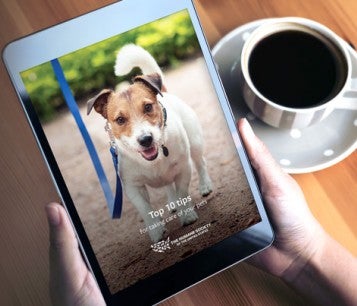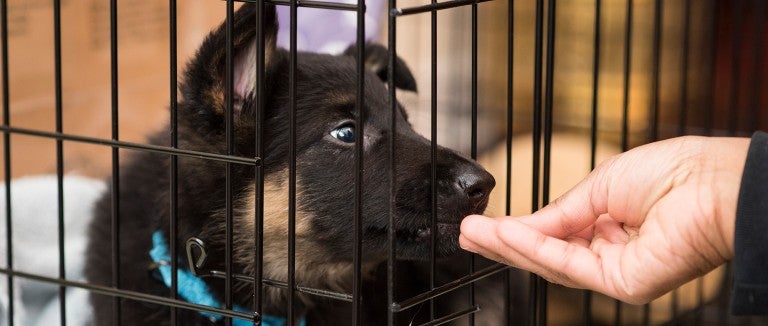Crate training a puppy takes advantage of the dog’s natural instincts to seek out a comfortable, quiet and safe place when the environment around them becomes too loud or overwhelming. It’s an important tool in preventing dogs from chewing on items in the home or during housetraining. Crates are also a safe way to transport your dog in the car.
Crating caution
A crate is not a magical solution to common canine behavior. If used incorrectly, a dog can feel trapped and frustrated. And for some dogs, crates will not be an option.
- While crates can be used to manage a behavior, they should never be used for punishment. For example, putting your dog in a crate with an interactive toy when guests come over to avoid mishaps with food or jumping is more effective than waiting for misbehavior and then putting your dog away. Regardless of the timing, using treats to entice your dog into the crate until they love going in on their own will ensure a positive association with it.
- Don't leave your dog in the crate too long. A dog who’s crated all day and night doesn't get enough exercise or human interaction and can become depressed or anxious. You may have to change your schedule, hire a pet sitter or take your dog to a daycare facility to reduce the amount of time they spend in the crate each day. Also, crates are not the only tool available. If you’re trying to prevent a puppy from chewing on things or having an accident at night, you can use a tether in your bedroom so they’re free to move about in a small space but can’t wander off while you’re asleep.
- Puppies under 6 months of age shouldn't stay in a crate for more than three or four hours at a time. They can't control their bladders or bowels for that long, even during potty training. The same goes for adult dogs being housetrained.
- Crate your dog until they are able to be alone in the house without accidents or destructive habits. You can graduate your dog from a crate to an enclosed area of your home, like your kitchen, before giving them access to the full house when you’re away.
- The crate should always have a comfortable bed and the door left open when you’re home so your dog can enter it when they need a safe space. This is also an indication that your dog needs some quiet time. Teach children and visitors to leave your pup alone if he or she goes into their crate.
- A crate may be your dog’s den, but just as you would not spend your entire life in one room of your home, your dog should not spend most of their time in a crate.
Can you imagine your dog spending years in a cage? Help us stop puppy mills.
Sign up to receive our exclusive e-book full of important information about caring for your pet, including training techniques and answers to frequently asked questions.

Crate selection
Several types of crates are available:
- Plastic (often called "flight kennels")
- Fabric on a collapsible, rigid frame
- Collapsible, metal pens
Crates come in different sizes and can be purchased at most pet supply stores or pet supply websites. Some are adjustable as your dog grows, which can be ideal for puppies.
The crate should be large enough for your dog to stand up and turn around in. If your dog is still growing, choose a crate size that will accommodate their adult size. Your local animal shelter may rent out crates. By renting, you can trade up to the appropriate size for your puppy until they reach adult size, when you can invest in a permanent crate.
The training process
Crate training can take days or weeks, depending on your dog's age, temperament and past experiences. It's important to keep two things in mind while crate training: The crate should always be associated with something pleasant and training should take place in a series of small steps. Don't go too fast.
Step 1: Introduce your dog to the crate
Place the crate in an area of your house where the family spends a lot of time, such as the family room. Put a soft blanket or bed in the crate. Take the door off or keep it propped open and let the dog explore the crate at their leisure. Some dogs will be naturally curious and start sleeping in the crate right away. If yours isn't one of them:
- Bring them over to the crate and talk to them in a happy tone of voice. Make sure the crate door is open and secured so that it won't hit your dog and frighten them.
- Encourage your dog to enter the crate by dropping some small food treats nearby, then just inside the door, and finally, all the way inside the crate. If they refuse to go all the way in at first, that's OK; don't force them to enter.
- Continue tossing treats into the crate until your dog will walk calmly all the way into the crate to get the food. If they aren’t interested in treats, try tossing a favorite toy in the crate. This step may take a few minutes or as long as several days.
Step 2: Feed your dog meals in the crate
After introducing your dog to the crate, begin feeding them their regular meals near the crate. This will create a pleasant association with the crate.
- If your dog is readily entering the crate when you begin Step 2, place the food dish or interactive puzzle toy stuffed with food all the way at the back of the crate.
- If they remain reluctant to enter, put the dish only as far inside as they will readily go without becoming fearful or anxious. Each time you feed them, place the dish a little further back in the crate.
- Once your dog is standing comfortably in the crate to eat their meal, you can close the door while they’re eating. The first time you do this, open the door as soon as they finish their meal. With each successive feeding, leave the door closed a few minutes longer, until they’re staying in the crate for 10 minutes or so after eating.
- If they begin to whine to be let out, you may have increased the length of time too quickly. Next time, try leaving them in the crate for a shorter time period.
Step 3: Practice with longer crating periods
After your dog is eating their regular meals in the crate with no sign of fear or anxiety, you can confine them there for short periods of time while you're home.
- Call them over to the crate and give them a treat.
- Give them a voice cue to enter, such as "crate." Encourage them by pointing to the inside of the crate with a treat in your hand.
- After your dog enters the crate, praise them, give them the treat and close the door.
- Sit quietly near the crate for five to 10 minutes and then go into another room for a few minutes. Return, sit quietly again for a short time and then let them out.
- Repeat this process several times a day, gradually increasing the length of time you leave them in the crate and the length of time you're out of sight.
- Once your dog will stay quietly in the crate for about 30 minutes with you mostly out of sight, you can begin leaving them crated when you're gone for short time periods and/or letting them sleep there at night. This may take several days or weeks.
Step 4, Part A: Crate your dog when you leave
After your dog can spend about 30 minutes in the crate without becoming anxious or afraid, you can begin leaving them crated for short periods when you leave the house.
- Put them in the crate using your regular command and a treat. You might also want to leave them with a few safe toys in the crate.
- Vary the moment during your "getting ready to leave" routine that you put your dog in the crate. Although they shouldn't be crated for a long time before you leave, you can crate them anywhere from five to 20 minutes prior to leaving.
- Don't make your departures emotional and prolonged—they should be matter-of-fact. Praise your dog briefly, give them a treat for entering the crate and then leave quietly.
When you return home, don't reward your dog for excited behavior by responding to them in an enthusiastic way. Keep arrivals low-key to avoid increasing their anxiety over when you will return. Continue to crate your dog for short periods from time to time when you're home so they don't associate crating with being left alone.
Step 4, Part B: Crate your dog at night
Put your dog in the crate using your regular command and a treat. Initially, it may be a good idea to put the crate in your bedroom or nearby in a hallway, especially if you have a puppy. Puppies often need to go outside to eliminate during the night and you'll want to be able to hear your puppy when they whine to be let outside. Older dogs should also initially be kept nearby so they don't associate the crate with social isolation.
Once your dog is sleeping comfortably through the night with the crate near you, you can begin to gradually move it to the location you prefer, although time spent with your dog—even sleep time—is a chance to strengthen the bond between you and your pet.
Potential problems
Whining: If your dog whines or cries while in the crate at night, it may be difficult to decide whether they’re whining to be let out of the crate, or whether they need to be let outside to eliminate. If you've followed the training procedures outlined above, then your dog hasn't been rewarded for whining in the past by being released from their crate. If that is the case, try to ignore the whining. If your dog is just testing you, they'll probably stop whining soon. Never punish them for whining.
If the whining continues after you've ignored them for several minutes, use the phrase they associate with going outside to eliminate. If they respond and become excited, take them outside. This should be a trip with a purpose, not play time. Stand in one spot in your yard where they normally go to the bathroom and wait. If you're convinced that your dog doesn't need to eliminate, the best response is to ignore them until they stop whining. If you've progressed gradually through the training steps and haven't done too much too fast, you'll be less likely to encounter this problem. If the problem becomes unmanageable, you may need to start the crate training process over again.
Separation anxiety: Attempting to use the crate as a remedy for separation anxiety won't solve the problem. A crate may prevent your dog from being destructive, but they may get injured in an attempt to escape. Separation anxiety problems can only be resolved with counterconditioning and desensitization procedures. You may want to consult a professional animal-behavior specialist for help.

